






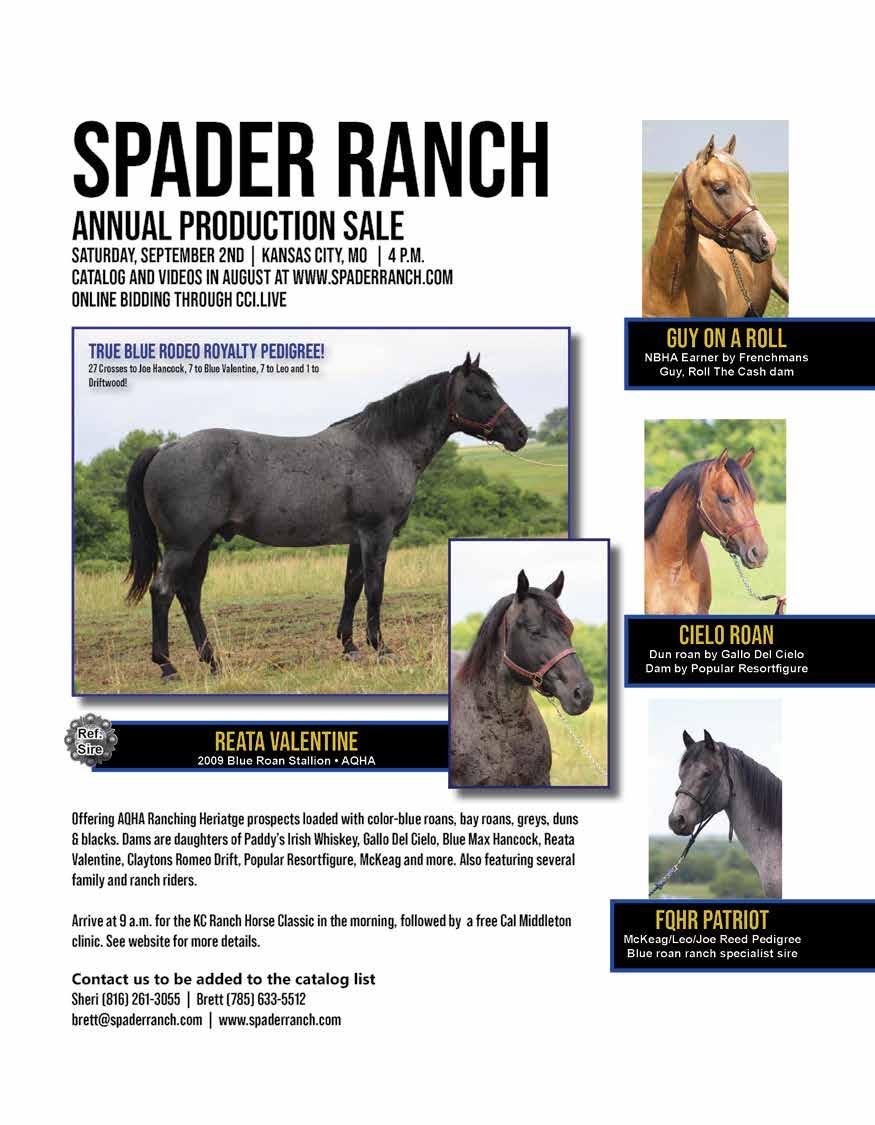
............................................................................................................................................................................................................... ............................................................................................................................................................................................................... ...............................................................................................................................................................................................................

Working Horse Magazine suMMer 2023 7 ............................................................................................................................................................................................................... WorkingHorseMagazine.coM | suMMer 2023 Mike Gerbaz | Managing Partner & Sales mikegerbaz@gmail.com | 970.948.5523 ............................................................................................................................................................................................................... Working Horse Magazine has been serving the performance horse industry since 1997. Main Office | 355 Watson Divide Road, Snowmass, CO 81654. For questions regarding subscriptions and distribution call 970.948.5523. The views and/or opinions in articles and advertisements do not necessarily reflect those of Working Horse Magazine and are the responsibility of the author or advertiser. CONTENTS Jane Klingson | Sales janeklingson@yahoo.com | 515.571.2832 Competitor News | Art & Production competitornews@yahoo.com | 541.938.0608 ............................................................................................................................................................................................................... | 14 Mares N More Useeit 28 Dental Issues May Cause Performance Problems 34 The Working Lines stan Weaver QUarter Horses 60 Ranch Real Estate 66 Products you need Trailers, Ranch Land, Suplements, Supplies, + more 68 WHM Horse Sale Calendar WEAVER QUARTER HORSES Weavers Heaven Too ridden by 13X CFr QUaliFier 3X Canadian HP CHamPion 2017 & 2021 Canadian tie doWn CHamPion riley Warren Pictured above is Nancy & Stan Weaver Read their story & see their sale ad on pg 34 Photo by Wildwood Imagery WeaverHorses.com
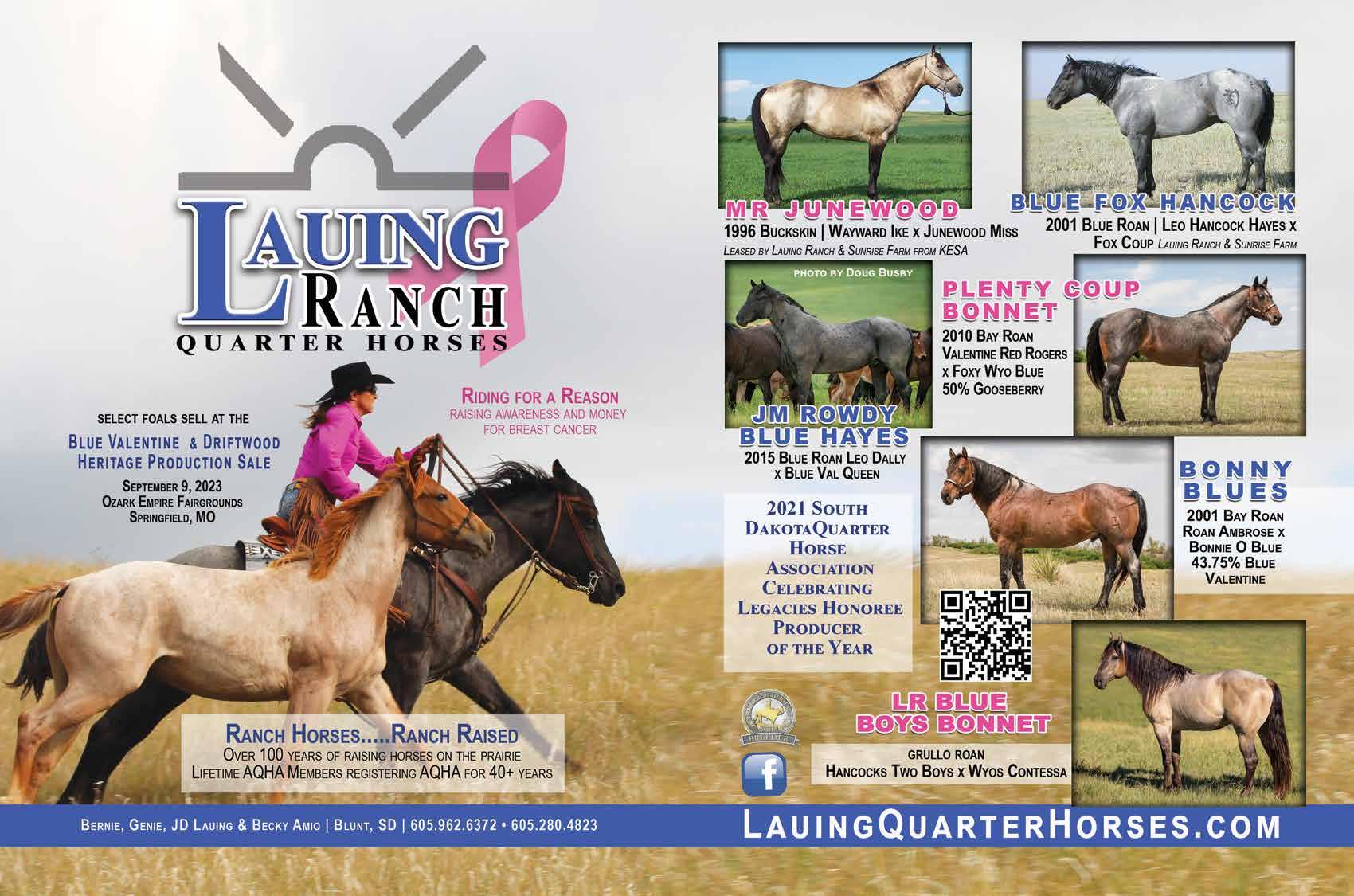



No matter what you're looking for, we have you covered. From horse and livestock trailers to utility and cargo trailers, our extensive selection ensures that you'll find exactly what you need. And with our expert team of professionals, we can help you make an informed decision and find the trailer that perfectly fits your needs and budget.




™ nationaltrailersource.com Ask About Our Free Freight Program 0% Down with Approved Credit Best Price Guarantee
 By Larry Thornton
By Larry Thornton
l Hoots was an Oklahoma horseman with a dream to win the Kentucky Derby, the most prestigious race in America and maybe the world. Sadly, his dream was fulfilled after his death. His wife Rosa did it for him with Black Gold, a son of his race mare Useeit. But at the same time, it is the story of Useeit’s influence on the American Quarter Horse, an influence that lets her serve as one of our Mares With More.
Useeit was foaled in 1907 on the ranch of her breeder C. B. Campbell. Campbell is a major contributor to the development of the American Quarter Horse. We don’t realize until we research the history of the state of Oklahoma that Campbell becomes a prominent figure in this state’s history. He played a key role in the founding of three towns Minco, Chickasha, and Oklahoma City. Some of his activities include being the founder of the First National Bank of Minco and helping form the First National Bank of Chickasha, serving as its President for 38 years. His role in Oklahoma City comes through land ownership, as he owned land where the city is now located.
Despite his success in founding towns, C. B. Campbell was a rancher first. He was known for his success with cattle and was the promoter of the cattle feeding stock pens in Chickasha, Oklahoma. But he was most famous for his horses. He was a breeder of polo ponies and racehorses. His obituary described how “he brought Eastern teams to Oklahoma to compete with his polo team. His team would win. His polo ponies were world famous.”
The success of Campbell as a breeder of polo ponies and racehorses was based on the horses he used. One of his stallions was Bonnie Joe. Bonnie Joe was the sire of Useeit. Bonnie Joe was a son of Faustus by Enquirer. Faustus was out of Lizzie G. This makes Faustus a full brother to Mannie Gray, the dam of legendary speed sire Domino.
Olin Gentry, one of the most influential men in modern thoroughbred breeding, gives us some personal insight into the Bonnie Joe horses. Gentry was the manager for Col. E. R. Bradley’s Idle Hour Farm, and then John W. Galbreath’s Darby Dan Farms. Gentry was involved in the breeding of nine horses that are credited with 13 wins in the Kentucky Derby, Preakness, and the Belmont Stakes to go along with one English Derby winner.
A sidebar that accompanied an Edward L. Bowen biography of Gentry called “A Ballad For The Time” in the April 30, 1983, issue of THE BLOOD HORSE quoted Gentry recalling his memories of the Bonnie Joe horses. He stated it this way, “I used to ride some of the Bonnie Joe’s,’ he said of his youth in Mexico and the Southwest. “One of them always started sideways—they didn’t have gates back then—but he could wheel around and just seem to fall out of there, and he’d be on top. I think I won seven races on him when he was ten.”
The dam of Useeit was Effie M by Bowling Green. Her dam was Alma Glyn by Glyndon. This makes Useeit a ¾ sister to Joe Blair, who was sired by Bonnie Joe and out of a Bowling Green mare. Joe Blair was the famous thoroughbred stallion that sired Joe Reed P-3, the double grandsire of Leo.
Al Hoots bought Useeit racing her for seven years. She amassed a record of 34 wins in 122 starts. She placed 38 times. She was noted as a sprinter that was not very good beyond six furlongs. She raced at such famous tracks as the Fair Grounds in New Orleans. She went against all comers, including the legendary Pan Zarita, a mare she was never able to defeat.
Hoots was racing his mare in Mexico. It seems that for whatever reason, Hoots entered his pride and joy in a “claiming race.” No one knows for sure why he would do that because he could lose his mare if someone claimed her. One report stated that the men that owned the participants in the race assured him they would not put a claim in on the mare. Well, somebody went back on his word and claimed her. But that didn’t stop Hoots from leaving Mexico with his mare. Some reports say he did it at gunpoint. He was then banned from racing, and his mare was banned from the Studbook.
When Hoots returned home, he became ill and died. This is where several versions exist in that Hoots asked his wife, Rosa, to not sell Useeit and to breed her to a good Kentucky thoroughbred. Some say he specifically told her to breed her to Col. E. R. Bradley’s stallion Black Toney.
Col. E. R. Bradley and his stallion Black Toney is a major part of the story. Bradley is credited with getting Useeit back into the Studbook. He had seen the mare run at the Fair Grounds, and he was partial to this type of mare. Edward Bowen’s biography of Gentry recalled how Bradley was a stern man, but he “was a kind-hearted man.” Of course, Olin Gentry being the manager of the Idle Hour Farm and his association with Bonnie Joe horses in his youth gives us another interesting fact in this story.
Rosa Hoots held to her husband’s wishes and kept Useeit. Rosa was an Osage Indian that, at first, didn’t have the money to send Useeit to Kentucky. But when the Osage Indians struck oil, and the tribe members benefited from the oil royalties, she had the money to send Useeit to Kentucky.
Useeit was bred to Black Toney, foaling a black colt in 1921. The Osage Indian success with oil gave the new black colt his name Black Gold. Black Gold went on to a highly successful race career, winning 18 of 34 starts. He fulfilled Al Hoots’ dream by winning the 50th Anniversary of the Kentucky Derby. He also won the Louisiana Derby, Ohio Derby, and Chicago Derby. He was the first horse to win four derbies. He didn’t compete in the Preakness Stakes or the Belmont Stakes.
Black Gold was retired but proved to be sterile, and thus, they took him back to the track where at the age of five, he broke down in the Salome Purse. He was buried in the infield of the Fair Grounds just as Pan Zarita was when she died.
14 Working Horse Magazine suMMer 2023
A ........................................................................................................................................................................................................................................................................................................................................................................................................................
mares WitH more | Useeit

........................................................................................................................................................................................................................................................................................................................................................................................................................
The success of Black Gold allowed Useeit to go back to the court of Black Toney, and in 1924, she foaled Beggar Boy. It is through Beggar Boy that Useeit makes much of her contribution to the American Quarter Horse. Reports vary, but most of them say that Rosa Hoots was the breeder of Beggar Boy. The Equineline.com pedigree for Beggar Boy gives no breeder for this horse. Thoroughbred Pedigree Query indicates that Col. E. R. Bradley is listed as his breeder. Beggar Boy went to the track with 39 starts earning a modest $5,662. He won five starts with seven seconds and eight-thirds.
The next breeder to enter the picture is Ronald Mason of Nowata, Oklahoma. Mason is a major breeder that stood the AQHA Studbook Foundation sire Oklahoma Star P-6 during this stallion’s last years. Mason added Beggar Boy to his stallion roster, and as we often say, the rest is history. He bought Beggar Boy from Rosa Hoots for $2,000.
Ronald Mason and his Cross J Ranch became synonymous with good quarter horses. His sire record shows that he sired 47 foals, with four official starts and two earning an ROM in racing and one stakes placed runner. Beggar Boy was an especially good sire of rodeo horses that were successful in tie-down roping, steer wrestling, steer roping, heading and heeling.
Mason reported to Franklin Reynolds in The American Quarter Horse Journal biography “The Story of Oklahoma Star,” which appeared in the June 1957 issue, that his “best horses” came from the “mingling” of Oklahoma Star and
Beggar Boy. It was this story that told that Rosa sold Beggar Boy to Mason.
A gelding that represents this cross was Baldy Boy by Beggar Boy, and his dam was V’s Peaches by Oklahoma Star P-6. Baldy Boy was a successful roping horse and racehorse. He was reportedly used by such noted ropers as Jess Goodspeed. Baldy Boy was rated AA on the track. This horse equaled or set 8 track records at three different racetracks. Four of these records came at the Burwell, Nebraska track, where he set track records at distances from 220 to 330 yards. He set a track record for 250 yards at Burwell, going in the time of 14.5 seconds, and then broke his own record the next year, going 250 in 13.9 seconds.
Beggar Girl was another runner sired by Beggar Boy and out of the Oklahoma Star mare named Baldy Girl. Beggar Girl was the stakes-placed runner with a second in the Buttons and Bows Stakes at Albuquerque. She was another AA race mare, just like Baldy Boy, when AA was the highest rating. Beggar Girl became a broodmare for Walter Merrick.
Beggar Girl introduces us to the producing daughters of Beggar Boy, which is a major source of Useeit’s influence on the modern quarter horse. Beggar Boy, the broodmare sire, had 35 daughters and produce 85 starters with 49 racing ROM with one stakes winner and five stakes placed runners.
Beggar Girl was the dam of six racing ROM runners. Her son Leo Bingo (bred by Merrick) was not only ROM on the track but also ROM in the arena and an AQHA Champion. Leo Bingo counts among his performers the 1969 NCHA
16 Working Horse Magazine suMMer 2023
Non-Pro Futurity Champion Chickasha Bingo and the 1975 NCHA Non-Pro Derby Co-Champion Chickasha Anita. Leo Bingo is the broodmare sire of Bingo Quixote, the 1980 NCHA Non-Pro Derby Reserve Champion. Bingo Quixote is the dam of the 1988 NCHA Super Stakes Open Reserve Champion Bingo Hickory. Bingo Quixote is the dam of Bingos Lena. She, in turn, is the dam of Dually Lena, the 1995 NCHA Open Futurity Reserve Champion.
Some other producing daughters of Beggar Boy include Toots B, Little Peach, and Beggar Pokey. Toots B was a full sister to Beggar Girl, being out of Baldy Girl. Toots B produced seven ROM from six performers, with two racing ROM and five performance ROM. Her leading performers were the AQHA Superior cutting horses Vandal and Mr Sagey. Both were NCHA money winners.
Vandal is the broodmare sire of Personality Doc, an AQHA World Champion Cutting Horse. Personality Doc is the sire of Doc Per, 1984 NCHA Open Futurity Champion. Doc Per was also the 1985 NCHA Open Super Stakes Co-Champion. Doc Per is the sire of Dixiland Docs Per, the 1991 NCHA Open Derby Champion. Vandal is also the sire of Miss Joann Van. Miss Joann Van is the dam of Joann Freckles, the 1988 NCHA Non-Pro Super Stakes Co-Reserve Champion.
Brooks’ Tzena by Starway by Oklahoma Star P-6 was an ROM racing daughter of Toots B. This mare is the dam of Heleo. Helio was a ROM arena horse and NCHA money earner. He is the sire of Holleo, an AQHA halter point earner with 8 points. She is the dam of Docs Stylish. Doc’s Stylish is the dam of Doc’s Stylish Oak. Docs Stylish Oak is the sire of such noted horses as Stylish and Foxie, the 1997 NCHA Super Stakes Open Reserve Champion, Stylish Playin, 1998 NCHA Non-Pro Super Stakes Reserve Champion, and Playin Stylish, the 1999 NCHA Super Stakes Open Champion. Docs Stylish Oak is the sire of winners that have earned $8,673,024.
Little Peach was another Beggar Boy/Oklahoma Star cross. Little Peach was bred by Ronald Mason but ended up in Arizona with Glenn Chipperfield. Her last owner was Vern Kelsey of Idaho. She produced top foals for all three of these breeders as the dam of 11 AQHA racing ROM runners. Her leading performer was the AQHA Champion, Tinky Poo. This stallion earned 25 halter points and four performance points. He was also ROM in racing. Tinky Poo is the sire of such AQHA Champions as Tinky Louie, Tinky Hawk, Sweety Poo, and Hobby Horse.
Hobby Horse was a successful sire, with his most noted performer being the AQHA Hall of Fame inductee Expensive Hobby. Expensive Hobby was the 1976 AQHA Open World Champion Senior Working Cowhorse, the 1979 AQHA World Champion Senior Working Cowhorse, and the 1979 AQHA World Champion Senior Reining Horse. He earned money in the NRHA and the NCHA, as well as earning an AQHA Superior in cutting.
Hobby Horse was the sire of Poo Bug, the dam of Super Poo. Super Poo was the dam of Hicapoo, the 1994 NCHA Horse of the Year as the winner of the NCHA Open Derby
and as the NCHA Open Super Stakes Reserve Champion. Hicapoo is a proven producer through foals like Capoo, a third-place finisher in the 1999 NCHA Open Futurity. Capoo is the dam of horses that have won $776,367.10, with her top money winners being Al Poocino ($255,332.00) and Bob Dualin ($222,402.88).
Tinky Ann is a daughter of Tinky Poo. She is the second dam of the legendary quarter running horse Charger Bar. Charger Bar was out of LaRee Bar, who was out of Tinky Ann. Charger Bar was the 1971 AQHA World Champion Racing American Quarter Horse. She was a three-time World Champion American Quarter Running Mare. She also is in the AQHA Hall of Fame.
Another racing champion from a Tinky Poo mare was Mr Tinky Bar by Rocket Bar by Three Bars. Mr Tinky Bar was the 1963 AQHA Racing Champion Two-Year-Old Colt. His dam was Tinky Lady.
Glenn Chipperfield also took the Beggar Boy mare Beggabird to Arizona. She was out of the Oklahoma Star mare Star Bird. She produced two foals for Chipperfield. They were Jack Hammer, the foal Beggabird was carrying when sold to Chipperfield. This stallion became a halter point earner. The next foal was Bill’s Beggar by Chicaro Bill. This stallion earned his racing ROM and was a track record holder at Ruidoso, going 250 in 14 seconds flat.
The next owner of Beggabird was Harry Irving of Skull Valley, Arizona. Irving stood the stallion Wayward Irving. When bred to Wayward Irving, Beggabird produced five ROM race and show horses, including Wayward Win ROM at racing and show, as well as an NCHA money earner.
Beggars Pokey was a black mare sired by Beggar Boy and out of Poco Antes. The pedigree of Poco Antes is unknown. Beggars Pokey produced several ROM runners and performers, including the stakes placed Peter Hancock and Lowry Boy 2. The best runner out of Beggars Pokey was Pokey Vandy by Vandy. Pokey Vandy was a stakes winner in the Rocky Mountain QHA Futurity, the Gold Bar Stakes, and the Autumn Championship. She was the 1955 AQHA Racing Champion Aged Mare. She went on to be the dam of the great Pokey Bar, the 1961 All-American Futurity winner and the 1961 AQHA Racing Champion Two-Year-Old Colt, and the 1962 AQHA Racing Champion Three-Year-Old Colt.
One of the daughters of Beggar Boy was a mare named Black Widder. This 1941 mare was out of Grace H. Grace H is sired by Oklahoma Star P-6, and the dam of Grace H was Cutthroat. Cutthroat was the dam of Oklahoma Star P-6. The Franklin Reynolds story we quoted earlier in The American Quarter Horse Journal biography “The Story of Oklahoma Star” talks about how Oklahoma Star was bred back to his dam to get Grace H.
Black Widder was bred to Vandy to get the mare Beggar Vanet. This mare was the dam of the AAA-rated mare Miss Killoqua. Miss Killoqua was the dam of Sharper Image, who is the third dam of FDD Dynasty, an AQHA Champion Two and Three-Year-Old Colt, and now the successful sire of horses like the World Champions Danjer and Jessies First Down.
Working Horse Magazine suMMer 2023 17
One of the great ropers of all time was Ike Rude, an Oklahoma roper that was very familiar with the Mason-bred horses. He is the man that started the great Old Baldy in his famous roping career. Old Baldy was sold to Clyde Burk, and then Troy Fort roped on this great gelding, both winning World Championships on this great horse. Some consider Old Baldy, the greatest rope horse of all time. Old Baldy was not an Oklahoma Star or Beggar Boy-bred horse. He was sired by Old Red Buck P-9 and out of the famous foundation mare Babe Dawson.
Bay Babe was a full sister to Old Baldy. She was used in the Mason breeding program and produced a colt they called Buster. Beggar Boy sired Buster. Buster would become Ike Rude’s great roping gelding that he won many contests with.
The available produce record of Useeit provided from Equineline.com indicates that she was the dam of only two thoroughbred foals. The produce record through the AQHA for Useeit indicates that she was the dam of two mares. They are Catch Me, foaled in 1920, and U Tell Me, foaled in 1923. They were both sired by a horse named Jenkins Bob Wade. His pedigree is unknown. This Bob Wade is not to be confused with the famous racing gelding Bob Wade by Roan Dick.
Catch Me has established her own branch of the Useeit family. She did it while coming in contact with some famous people. We find Catch Me through the registration application of her daughter Chouteau. We see that the owner of Catch Me when Chouteau was conceived was Matthew “Bones” Hooks. Hooks was the famous black cowboy and horseman as well as a well-known civic leader that promoted the well-being of young blacks in communities like Amarillo.
Hooks, a member of the National Cowboys of Color Hall of Fame, was described in his Hall of Fame biography as a “cowboy and horse breaker” that “raised horses in partnerships with white men and became a top horse breaker.”
Hooks bred Catch Me to the famous John Wilkens, who was owned by G. B. Mathis. Both of these men are listed on the application as living in White Deer, Texas. Mathis was the last owner of John Wilkens, the famous son of Peter McCue, and the sire of Joe Hancock
The third man entering the picture was Fred Lowry, the famous Oklahoma rancher and roper. Lowry owned such famous horses as Zandy and Lowry’s Mabel. Lowry’s Mabel was the dam of the stallions Sport, Fred Lowry, and Star Duster. Lowry filled out the registration application to reg-

ister the mare Chouteau.
Chouteau was foaled in 1930 and registered in 1946. She produced several foals for Mathis, including Blue Boy Chouteau, Major Wilkens, and Regret. Her Fred Lowry foals include Gray Lowry, an ROM racehorse. He earned an A rating on the track. Her foal John Caston was the earner of three halter points. Gray Lowry was sired by Zandy, and Fred Caston was sired by Nowata Star by Oklahoma Star P-6.
Regret was bred by Mathis and registered when owned by L. W. Cox of Tulsa, Oklahoma. She was foaled in 1940. Her sire was Pyle’s Sonnie Boy. Regret was used as a broodmare by several breeders, including L. W. Cox, R. Q. Sutherland, E. W. Brown III, and Albert Paxton. She produced Jack Sparks, a stallion used by William R. “Bill” Thompson of Santa Rosa, New Mexico, and former AQHA President. Jack Sparks sired several AQHA Champions, including Bald Hornet Boy and Pino Connie.
Downpour was an A-rated race mare out of Regret. She was the dam of Drifting Miss. Drifting Miss was the dam of Duplicate Dude. This horse was Superior in trail and the earner of 59 AQHA performance points.
Amogret was sired by Tamo and out of Regret. She was the dam of only three foals. She was the dam of Leotam Adams and Frosty’s Jag. Leotam Adams by Leo was a stakesplaced runner with a third in the Triple R Futurity. He then went to the halter arena to earn 22 halter points. Frosty’s Jag by Coy’s Bonanza was an AQHA Champion with 42 halter and 37.5 performance points.
Tamet was an AQHA Superior Halter Horse with 105 AQHA halter points. He was the earner of one AQHA performance point. Tamet was a full brother to Amogret. Tamet was the sire of Superior Halter Mare Miss Tamet Cue, who earned 192 AQHA halter points. His other Superior winner was Harold’s Angel, with 77 AQHA performance points and a Superior in cutting. She also earned $11,956 in the NCHA. Tamadonna was the AQHA Champion sired by Tamet. Rose Bell was Tamet’s racing ROM daughter.
The story of Useeit is the story of how Al Hoots had a dream to win the Kentucky Derby. A dream that came true even after he passed away. But the success of Black Gold sent Useeit back to the court of Black Toney, producing Beggar Boy. It was through this second mating that a lot of people fulfilled their dreams of owning a good horse. So, our look at Useeit is a fitting tribute to the little Oklahoma mare, proving that dreams do come true as one of our Mares With More.
About the Author |
18 Working Horse Magazine suMMer 2023
...................................................................................................................................................................................................... ......................................................................................................................................................................................................
Larry Thornton is a Pedigree Analyst and freelance writer for Working Horse Magazine, Speedhorse and Quarter Horse News. Thorton started his writing career in 1984 with his first article being printed in the Speed Horse Magazine. He was also an Agriculture Instructor for 37 years.














Dental Issues May Cause Performance Problems
By Heather Smith Thomas................................................................................................................................................................................................................................................................................................................................................................
The horse’s teeth are crucial for proper eating/chewing and therefore a big factor in whether or not the horse obtains adequate nutrition. Thus healthy teeth are important for health and fitness. Teeth also play a role in performance of an equine athlete, in that tooth problems can lead to pain, which can lead to behaviors that can affect performance. Sometimes a performance problem may be subtle or not readily recognized as being a tooth problem, so it’s important to figure these things out—with proper diagnosis and treatment—in order to address and correct the underlying issue.
Mary Delorey, DVM (Northwest Equine Dentistry, Seattle, Washington) deals with many dental issues in horses and says the majority of dental problems that translate into performance issues are the conditions that cause pain. Points on the teeth that contact soft tissues of the mouth are a frequent cause of pain.
“Normal wear of teeth can lead to sharp points, and these are probably the most common problem, since the lower jaw is about 30% narrower than the upper jaw. Horses need a certain amount of exposed enamel to grind their food. In the wild, sharpened projections don’t create much problem, but when we put tack on the horse’s face and a bit in the mouth, this changes things,” she explains. Tack puts pressure in areas that wouldn’t otherwise have pressure against them.
“Domestic horses that are ridden or driven must deal with issues that a wild horse wouldn’t have to cope with, such as a bit in the mouth, a noseband, etc. Headgear can place direct physical pressure on soft tissues. When there are sharp enamel points next to those tissues, they can cause pain and damage to the soft tissues,” she says.
“These problems are usually due to something humans have put on the horse’s head, pushing against soft tissues of the mouth. Another example (which is also human-caused) would be a horse that holds tension in the jaw muscles, just like some people who habitually clench their jaw,” says Delorey.
“Imagine this in a horse, with sharp enamel points (whereas humans have smooth enamel-covered teeth). This tends to cause more physical damage in the horse than in a person. Whether it’s while ridden or in a stabling situation, the horse may be tense and nervous because these are not natural conditions for a horse.” Routine dental care is aimed at two things—comfort for the horse, and dental health (which affects longevity).
“Regarding performance issues, sharp points in the wrong places is probably the number one cause. Routine dental care involves floating (rasping) and smoothing off those points. It’s not just on the top teeth, but also the bottom, since these can lacerate the tongue. A horse’s tongue, is huge and long. It fills nearly all the oral cavity when the horse’s mouth is closed. There is no place for that tongue to go, to get away from the discomfort of sharp points on the teeth, especially if the mouth is being held closed by tack,” she explains.
“Many riders recognize that mouth gaping, jaw moving, or the tongue sticking out are resistance behaviors--usually caused by pain. Often those behaviors can be eliminated with routine dental care, removing obvious and simple sources of pain,” says Delorey. That’s the first step.
WOLF TEETH - “There is a lot of controversy about the presence, absence or shape of wolf teeth. These teeth are actually the first premolars, though quite a bit smaller than the teeth behind them,” she says.
“Many people feel that those teeth don’t cause a problem as long as they are not sharp. This may be true, but a lot of horsemen think it is better to remove those teeth, to eliminate them as a possible cause of bad behavior. Often these are removed when the horse is young, so they never become a problem. It probably doesn’t do much harm to remove them, and in my practice I routinely remove wolf teeth from many young horses destined to be performance horses, although this could certainly be a case-bycase decision. If I encounter wolf teeth in an older horse, and the horse is not experiencing any issues with the bridle or bit, I leave them alone.”
Then there are the young horses that were started in training without checking for wolf teeth, and by the time that horse is 4 or 5 it is experiencing problems. “At that age, it can sometimes be more difficult to remove them because their attachment to the surrounding bone is stronger. Older wolf teeth are more likely to be broken, due to excessive pressure from the bit. These teeth are located close to where the bit sits, so they can definitely cause a problem—but in cases,” she says.
“In my opinion, un-erupted wolf teeth are more typically a cause of pain than a normally erupted tooth. Teeth that are still under the gum surface are usually not in a normal position, and more likely to be pressed by the bit since they are commonly located farther forward than a normally erupted wolf tooth. Un-erupted wolf teeth do not have a normal attachment ligament and are not as stable. If there is not a stable, strong structure under the gingiva, these teeth can be more painful. This is my observation, after 25 years of equine dental work,” says Delorey.
It takes an experienced eye and the ability to feel all the tissues within the mouth, to check for these problems. “It also involves listening closely to the client and how the client experiences what the horse is doing. I look into the horse’s mouth and instead of saying, ‘Oh! Look what I found!’ I ask the rider whether he/she thinks the horse is balanced in the bridle. If they say yes, then I don’t worry about that tooth. If the rider feels the horse has some resistance in the bridle, I ask which side they are feeling more resistance. That way, I am not biasing their answer. This helps me decide whether wolf teeth need to be modified or removed,” she says.
OTHER DENTAL REASONS FOR PER-
FORMANCE-RELATED
PROBLEMS
– A diseased tooth can lead to problems. “It may be infection of the tooth root, a fracture, or a periodontal disease. These must be evaluated on an individual basis. If the diseased tooth is in the front of the mouth where it may be in direct or secondary contact with the bit or tack, it may be causing discomfort and a direct source of pain. Many diseased teeth, however, are much farther back, far away from the bit and often nowhere near contact with any pressure from the bridle. Those must be evaluated to determine whether they are causing a performance problem, and this can be tricky,” says Delorey.
28 Working Horse Magazine suMMer 2023
dental issUes may CaUse
PerFormanCe Problems


Thomas................................................................................................................................................................................................................................................................................................................................................................
Many people think the horse’s teeth are like ours and that the horse would react like we would if we had a toothache and won’t be performing very well. “Horse are very tough animals and very stoic. They tend to keep doing their job and keep eating, unless there is a very serious problem in the mouth. It has to be very serious, for them to stop eating. Sometimes performance-related issues that are dental in origin can be quite subtle and these can be almost impossible to confirm,” she explains.
“I’ve had many cases with severe abscesses that have resulted in sinus infections. The horse has a head full of pus and is still doing its job. The owner may not know that anything is wrong until the horse has a nasty nasal discharge on one side. Yet the day before the discharge is noticed the horse was still performing normally.” The infection didn’t cause enough discomfort for the horse to act any different.
Some horses have performance problems related to malocclusions (mismatched jaw/teeth). “For example, there may not be any sharp points and the horse is not cutting his cheek or tongue and there is nothing uncomfortable about the bit, no dental disease, yet the way the horse’s cheek teeth meet up is not a normal, uniform configuration. The most common of these malocclusions is called wave mouth. If this occurs in a dressage horse, for instance, wearing a double bridle, this could create a problem. This is a horse with a lot of hardware in the mouth, and a lot of leather encasing his head, and probably a dropped noseband that forces his mouth to stay closed,” she says.



“Anything that keeps that horse from being able to open his mouth very far (such as a noseband), with a wave malocclusion or hooks in the back or the front, makes it so that horse cannot effectively open his mouth to adjust the way his teeth meet or don’t meet. His mouth is forced into a certain position, restricted by the way the teeth meet, and this may be uncomfortable. Horses that can open the mouth can adjust the jaw position. A horse that is being asked to collect (without his mouth being forcibly closed) can open his mouth and move his jaws slightly, and stay comfortable. If he cannot open his mouth a few millimeters, he has no place to go to avoid
the pain—which in this case is caused by an uncomfortably placed jaw,” says Delorey.



“Collection requires a lot of muscular control and positioning through shoulder, neck, poll, temporomandibular joint (TMJ), lower jaw, etc. It is one fluid system, and if one part of the system is non-functioning it tends to negate the whole movement. There is very little science to back this up, but through years and years of working with performance horses and riders, I can speak with a fair amount of authority and say that severe dental malocclusions (which are fairly common) play a significant role in how that horse is able to perform athletically. Some horses can handle these types of adversity better than others, and some horses have to have everything perfect in order to perform optimally,” she explains. Some horses simply continue to do their job, no matter what. They have a different pain tolerance or personality, and keep going in spite of things that other horses can’t handle.
DIAGNOSING PROBLEMS
“Pinpointing performance problems and finding an oral or dental source is often more art than science. There is rarely just a single source for a performance problem; it’s usually due to multiple issues that have been building up over time. Only rarely do I get to say ‘Here is the problem and we can fix it.’ It’s more common to find potential problems, correct them, and then work on the additional problems. Often if you can correct one problem in the chain, however, some of the others self-correct,” says Delorey.
Some problems are cumulative and there are multiple factors that build on each other and become overwhelming, resulting in a performance issue. “Tracking these things down is definitely an art. Sometimes we get lucky and sometimes it’s difficult. Most times it becomes a process of eliminating one thing at a time, as a potential source of the problem. If you are experienced and know how a horse’s mouth works, you know what kinds of things are likely to (or could possibly) cause a problem,” she says.
30 Working Horse Magazine suMMer 2023
3 YEAR OLD FIILY WITH IMPACTED WOLF TOOTH
DENTAL EXAM
ISSUES THAT MASQUERADE AS DEN-
TAL PROBLEMS – “Clients may come to me with a question about a possible dental problem. Maybe the horse is sticking his tongue out when asked to bend to the left. Yet I can’t find a dental problem. The horse is experiencing pain from another source when bending left, and his frustration is exhibited by sticking his tongue out. All he is saying is that it hurts.” That’s his method of coping.
“There are many things that are not dental related but the horse is expressing pain by shaking his head, rooting downward on the bit or throwing his nose in the air, tossing his head repeatedly, sticking his tongue out, bracing on the bit, etc. Most performance issues are not dental-related but a lot of them manifest as head or neck behavior because the rider is inhibiting the head and neck movement or because this is the only way the horse can show his frustration. Most horses are not going to buck or rear. They simply keep saying ‘You are bothering me!’ or, ‘I don’t understand what you want!’ with their head and neck action.” And this can be misinterpreted as a dental problem.
TMJ ISSUES
“Sometimes malocclusions that inhibit movement of the jaws (such as hooks that often accompany “wave mouth”) can lock the jaws in place; the horse cannot move the jaw in a normal range of motion. This is compounded when you keep the mouth closed,” says Delorey. When the rider is trying to collect the horse and have him flex at the poll, the hooks/ wave mouth hinders movement in the temporomandibular joint (TMJ) between the skull and the first vertebrae of the neck, in front of the poll.
enough to create space to free them, the jaws are locked together; the lower jaw can’t slide forward, so he can’t flex at the poll. Trying to force him to flex may create pain in the TMJ joint. If a rider doesn’t understand the problem and is frustrated about the horse’s unwillingness/inability to flex, the rider may resort to a tie-down and/or noseband to keep the mouth shut, inhibiting the horse’s efforts to do what the rider is asking him to do. This problem can generally be alleviated with proper dental care and by not forcing the horse to keep his mouth shut.

“True temporomandibular joint disease is rare, and this is a joint problem, like arthritis, rather than a dental issue. Cartilage changes, joint infections, bony enlargements that are traumatically induced or due to chronic misuse over a long period of time is uncommon in horses. Most people, when they say their chiropractor told them their horse has TMJ issues, don’t realize this is simply a huge catch-all phrase that doesn’t mean anything specific,” says Delorey.
TOOTH THAT NEEDS TO BE FILED DOWN
“That horse probably has some discomfort around the joint itself. There’s a lot of soft tissue (muscles, tendons and ligaments) that all attach around that joint. Just as in humans, many horses carry their tension in their jaw. The joint is fine, but the muscles around it get tired and sore. I believe (although we have no way to prove this in horses) that this is what may be happening in horses, as well, since true degenerative joint disease in the TMJ is very rare,” she says.
Flexing at the poll becomes a problem if the horse’s mouth is forced to stay shut and he can’t open it enough to free the jaws that are stuck together by the uneven teeth. For a horse to flex at the poll, the angle between head and neck changes, and the lower jaw has to slide/move forward a little. If the horse has anything in his mouth blocking that movement, such as hooks on the molars, and he can’t open his mouth
“If a chiropractor or another body-worker (massage, etc.) identifies tension or soreness in any of the soft tissues surrounding either side of the head, they may say the horse has TMJ. But the TMJ is a structure, not a disease. We have to identify other issues, including (but not limited to) dental problems that could be contributing to a horse’s holding tension in the jaw. Any kind of malocclusion that prevents free movement of the jaw could contribute to tension and tightness in the tissues surrounding that joint, and result in pain,” she explains.
Working Horse Magazine suMMer 2023 31
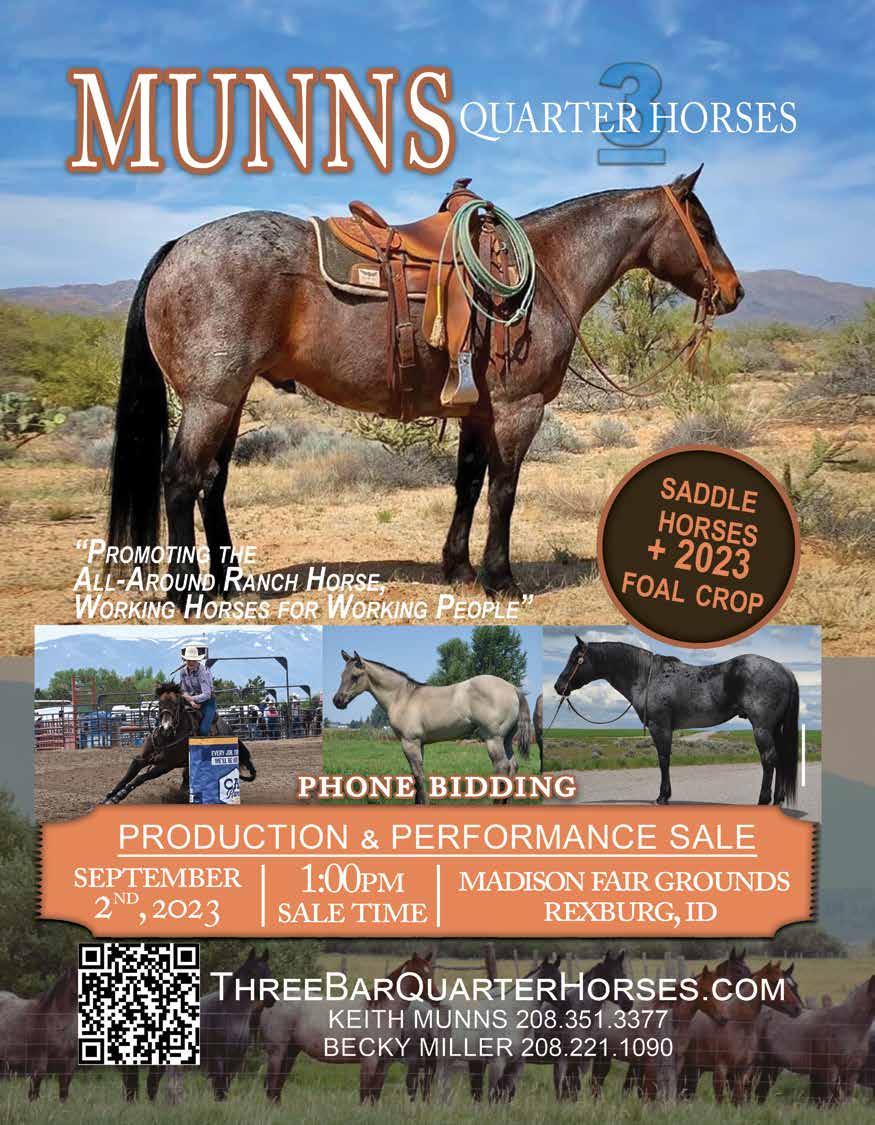


QUARTER HORSE P RODUCTION SALE September 8, 2023 Friday, 6 PM CDT Mobridge Livestock Market – Mobridge S.D. For more information & catalogs contact Darrell Schlepp - 605-850-8995 | fivearrow@westriv.com or Chad & Gary Pederson - 605-865-3190 | bhrredangus@lakotanetwork.com Catalogs can be viewed at www.fivearrow.com, www.pedersonbhr.com & on facebook. Sale will be live at www.cattleusa.com 24th Annual Dakota BREEDERS CLASSIC Offering an outstanding selection of per formance bred prospects from Five Arrow Quarter Horses, Broken Heart Ranch, Jace Booth, Paige Mollman, and LeAnn Bender.
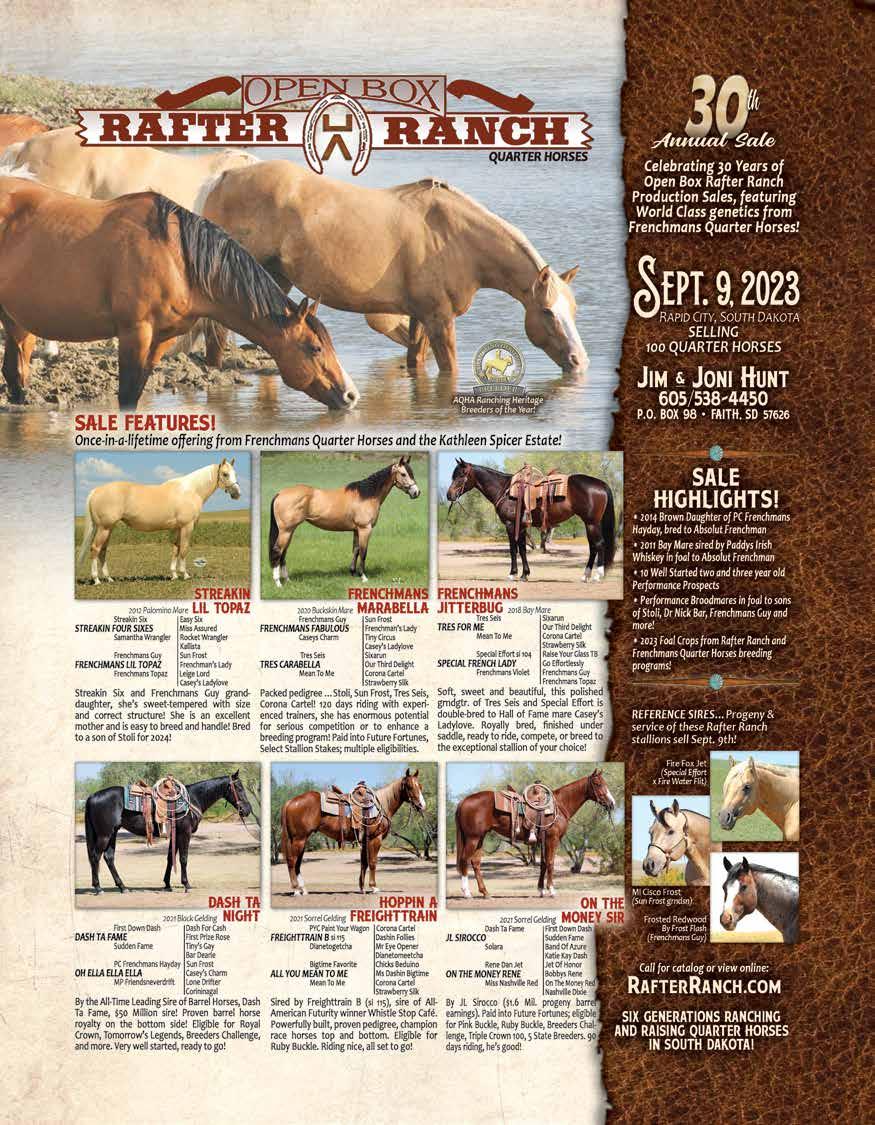
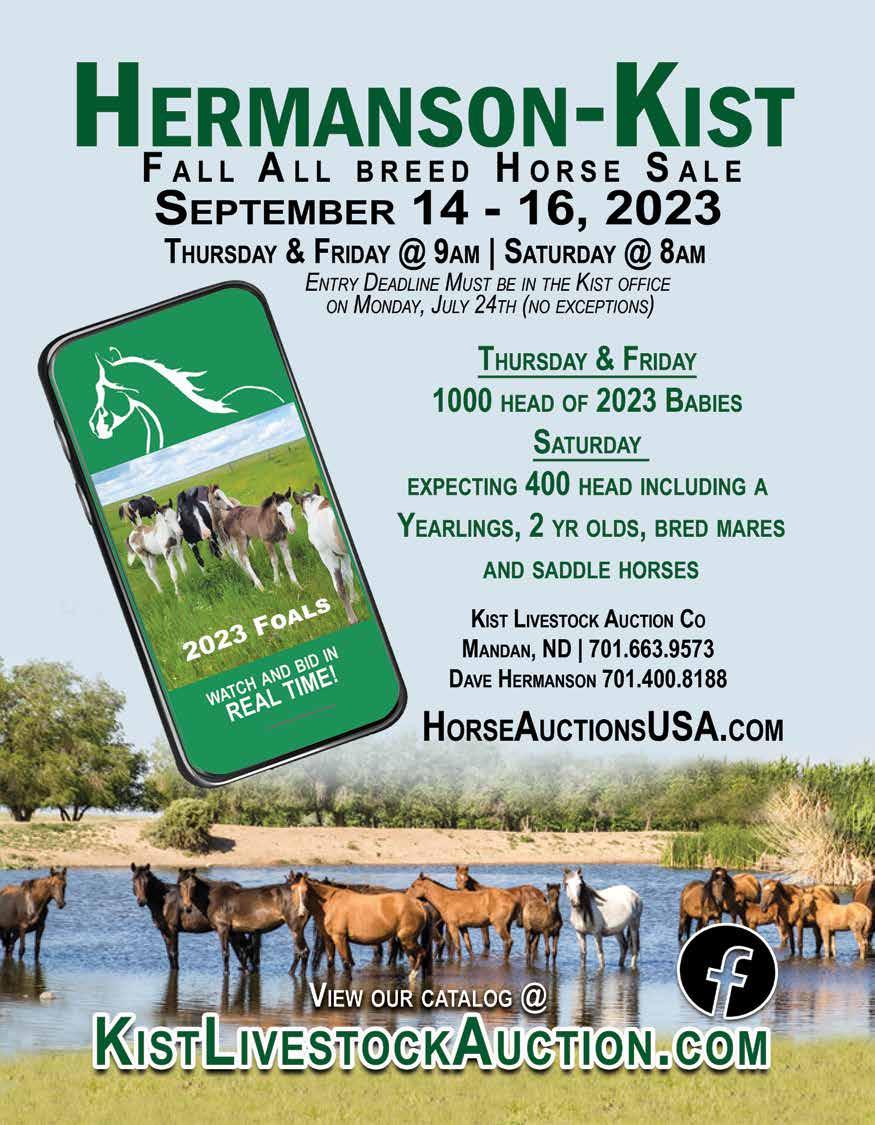

Cookin Merada
Wimpys Hi Roller
Sweet Gallo Oak

CD Cut The Lights
Just A Silver Duck
Rios Santana
A San Peppy Legend
Royal Vaca Rey
Jack Frost Edition
RWS Vacas Benito Bar
Legendary Cutter
Peppy San Holliday
RWS Benito Edition
Doseys Star

Foals
These Ranch Stallions
Selling
By
GEORGA and HEATHER SUTTON, DVM Gettysburg, South Dakota rsuttonhorses@hotmail.com www.raymondsutton.net 605-264-5452 or 605-769-0925 2021 RANCHING HERITAGE BREEDER TOP PRODUCTION SALE Ranching Heritage Breeder – 2x AQHA Legacy Breeder – American Quarter Horse Hall Of Fame Hosted Online by 72nd PRODUCTION SALE | SEPTEMBER 17, 2023 — Oldest Quarter Horse Production Sale In The World — Find the catalog at ProHorseServices.com


tHe Working lines | stan Weaver QUarter Horses
By Larry Thornton
W

hen the American Quarter Horse Association was formed in 1940, some notable horsemen came together to create a breed registry for the Steel Dust horses that represented a distinct type of horse. The original meeting took place at the home of Anne Burnett Tandy and her husband, James Goodwin Hall. Some of the major players at that meeting were Robert Denhardt, George Clegg, Jack Hutchins, Robert J. Kleberg Jr., W. B. Warren, and Jim Minnick. They were all actively involved in ranching as a business, except Denhardt, who traveled throughout the country gathering information that set the foundation of the breed. Many of his visits were to ranches that raised horses for ranch use, and they also made them available for sale to the public.
From this modest beginning, the American Quarter Horse was born, and the American Quarter Horse Association has grown to be the largest breed association in the World, and we have seen the breed go worldwide as well. But in the beginning, it was a fledgling association started by selling stocks in the Association. But to keep it going, they needed breeders with their horses to join the ranks. One of the sources for newly registered horses came from the ranchers. It was ranches like the King Ranch, Waggoner Ranch, the Four Sixes Ranch, the CS Cattle Company, the Pitchfork, the O RO Ranch, and many other ranches registering horses that brought numbers into the Association. The O RO Ranch, which was originally known as the Greene Cattle Company, had 900 horses inspected to be registered in 1940, and 250 of them were given a number. These ranches became a major source of newly registered horses, and as we look back, we see many of the significant early horses registered came from ranches. You might say these ranches became the backbone of the American Quarter Horse Association.
The role of the ranch-bred and raised horse continues today. With the ranch rodeos, We see the various ranches competing to be the best. The success of the ranch rodeo has come to the American Quarter Horse in the form of the Ranch Classes that display the qualities a good ranch horse must have. The significance of the ranch horse in the AQHA prompted the Best
Remuda Award, which honors a different ranch each year for the quality of the horse they use daily. When the AQHA named the Haythorn Cattle Company the first Best Remuda Award winner, they were the largest breeder of the American Quarter Horse. They also had regular production sales to disseminate their horses into the industry. You might say the ranch-raised horse is still the backbone of the American Quarter Horse Association.
The Stan Weaver Quarter Horses of Big Sandy, Montana, is raising ranch horses that follow this long-standing tradition set down by the founders of the Association. The success of this ranch horse breeding program is evident by garnering such titles as the 2020 AQHA Ranching Heritage Breeder of the Year Award. Stan has also been very active in the AQHA, serving on numerous committees, on the Executive Committee, and then serving as the AQHA President in 2019-2020. The readers of THE WORKING HORSE are familiar with the Weaver Quarter Horses as we have seen several articles, ads, and covers in the magazine over the years. But this time, I thought we should take a closer look at this ranch and their ranch horses.
Stan and Nancy Weaver breed ranch horses that satisfy their needs. Then they make their horses available through a production sale, sending them out as ranch horses, with some of them entering the arena as performance horses. The 2023 sale will be the 28th Weaver Quarter Horse Production Sale.
The Stan Weaver Quarter Horses is like many of the ranches. It has its roots in the settling of the American West. Stan will fill us in on the legacy of the Weaver family and their ranching heritage. He stated it this way, “The Weaver family left Tennessee in 1846. They went up the Oregon trail to Oregon. Then in 1886, the five brothers came to Montana to cowboy. That is what they did, they rode with the famous artist Charlie Russell, and then when the cowboy days were over, they just did different things. One of them became the first head of the Game & Fish Commission of Montana; another had a car dealership. My great-granddad William had a bar in Chinook. When my granddad Elmer was 16 years old, he left home as he never did like the bar. He bought and sold land, broke horses, and trailed horses. They took 300 loose horses to Canada one time.”
When my grandad passed away in 1952, he had four sons, and each one of those sons got a ranch. He had put together enough for them to each have a place. He bought the place that I’m on in 1925, and then my dad Arthur took over, and then I took over in 81 when my dad passed away.”

Next, Stan told the role the horse played over the years, “I was raised around horses, Thoroughbreds mostly. We always had two or three mares, but they weren’t quarter horses. We never really raised horses to sell just for the ranch. We would have a stud for a year or two and get rid of it. My dad always liked a little Tennessee Walker, so we had like a half Tennessee Walker.”
The American Quarter Horse enters the picture as Stan continues, “Then, in 1971, we bought the first quarter horse for the ranch. Her name was Pretty Miss Denver. She was my dad’s horse, he rode her, and then when he passed away, we never rode her again. She was 11 when he passed away, and we made a broodmare out of her. She was just a really good mare and a good foundation mare. I don’t know, probably 60 to 70% of our mares traced to that mare through different studs, and there are two or three mare lines through her daughters that she’s had that have produced good horses. It seemed like no matter what you bred them to; they were good horses.”
Pretty Miss Denver was bred by Frank Wetzstein of Mandan, North Dakota. Her pedigree tells us why she was a foundation broodmare. She was sired by Mr Blackburn 41 by Pretty Buck, the famous Waggoner Ranch stallion that was sired by Pretty Boy and out of a daughter of Buck Thomas by Peter McCue. The dam of Mr Blackburn 41 was Lady Cowan 6 by Blackburn, and she was out of a Cowan mare pedigree unknown.
Mr Blackburn 41 was the sire of five performers earning 142 points with three ROM and one Superior in Western Pleasure. The Superior performer was Miss Steel
Blue with 56 AQHA points, and the other ROM is Lady Buck 1 with 71.5 AQHA points with ROMs in the open and youth. His foal Tackie Blackburn was the winner of $5,465.74 in the NRHA with 13.5 AQHA points, and she was an AQHA Youth World Show finalist in reining.
The dam of Pretty Miss Denver was Mr 14’s Susie, a daughter of Mr Blackburn 14, a son of Poco Bob, who was sired by Poco Bueno and out of Lady Blackburn III by Blackburn. The dam of Mr Blackburn 14 was Lady Cowan 10 by Blackburn. This gives Pretty Miss Denver a breeding pattern of 3 x 5 x 4 to Blackburn. Mr Blackburn, 41, and Mr Blackburn, 14, were bred by Harold Schafer, founder of the Gold Seal Company, which had cleaning products like Snowy Bleach and Mr. Bubble. He formed the Blackburn Ranch by bringing stallions and
mares together from the Blackburn, Pretty Boy, and Poco Bueno bloodlines. Blackburn and Pretty Boy were Waggoner Ranch stallions that have proven to be great contributors to the American Quarter Horse.
An added note: Pretty Miss Denver and Miss Steel Blue are ¾ sisters by Mr Backburn, 41, and out of a daughter of Mr Blackburn, 14.
The dam of Mr 14’s Susie was Bert’s Susie Bee by Buster W by Bert P-227 by Tommy Clegg and out of Lady Coolidge by Beetch’s Yellow Jacket by Yellow Wolf, another Waggoner Ranch stallion. The dam of Bert’s Susie Bee was Bert’s Bay Susie by Sambo, and she was out of Dunny Bert by Bert P-227, giving Bert’s Susie Bee a breeding pattern of 2 x 3 to Bert P-227.
A review of the 2022 Stan Weaver Production Sale Catalog shows 30 foals being sold were out of the Pretty Miss Denver line of mares. One of her daughters, Call Me Blackburn, has 10 of the 30 foals traced through her to Pretty Miss Denver. The Pretty Miss Denver line of mares has produced a number of high-selling horses over the years showing the quality this line of mares produces.
Our conversation went on to the next mare, “Stormy Dun Dee was the first mare Nancy and I bought. Nancy rode her for, I don’t know, four or five years, and then we made a broodmare out of her, and I don’t know how many, but there are probably 20-30 mares out of her in the broodmare band.”
He continued, “She was the grand-dam of Ima Tuff Lena, the AQHA All Around High Point Junior Horse in 2009, and she
was reserve world champion head horse as a junior horse and as a senior horse, and then they sold her to Brazil. I have three full sisters to that mare in the broodmare band.”
Stan explained why they bought the Stormy Dun Dee, “She was a dun mare with no white like a real dark dun, and she has that dun factor in her colts. I mean, no white and really good that way. She was a descendant of Poco Bueno, and it was a way down, but just the color and no white was probably the biggest thing because, at that time, I didn’t know a lot about pedigrees.”
The sire of Stormy Dun Dee was Stormy Socks Comet by Comets Stormy by Skip Comet by Skipper’s King. Skipper’s King was sired by Skipper W by Nick Shoemaker, and he was out of Santa Maria by Plaudit. The dam of Comets Stormy was Sage Bush by Copper Nick by Nick Shoemaker, and he was out of Santa Maria. This makes Comet’s Stormy line-bred with a breeding pattern of 2 x 2 to the ¾ brother’s Skipper’s King and Copper Nick. The dam of Stormy Socks Comet was Twistie Socks by Easy Joe by Captain Easy by Cowboy P-12. Cowboy P-12 was the sire of Hired Girl, the dam of Skipper W, giving the pedigree of Stormy Socks Comet a breeding pattern of 5 x 4 to Cowboy P-12, who was sired by Yellow Jacket, a ranch sire for the Waggoner Ranch and some others.
A look at the dam side of the pedigree of Stormy Dun Dee will give us some familiar bloodlines. The dam of Stormy Dun Dee was Dee Loon by Poco Loon by Poco Dun by Poco Bueno. The dam of Poco Dun was Pretty Doll by Pretty Buck by Pretty Boy, and her dam was Dolly D, a daughter of Blackburn. The dam of
40 Working Horse Magazine suMMer 2023
Dee Loon was Clover Dun by Poco Blackburn. The dam Clover Dun was Clover Dee by Poco Blackburn. Poco Blackburn was sired by Poco Dell by Poco Bueno, and his dam was Carrie D by Blackburn. This gives Dee Loon a breeding pattern of 3 x 4 x 5 to Poco Bueno and a 5 x 4 x 5 to Blackburn. Some more of that Waggoner breeding, and by the way, Blackburn was a son of Yellow Jacket.
The dam of Ima Tuff Missy was Lady Beckwith Dee, a daughter of Stormy Dun Dee. Her sire was Go Beckwith Roan by Beckwith Dun. Beckwith Dun is sired by Classy Flap by Classy Bar. The dam of Go Beckwith Roan was Go Watch by Tiny Watch Star by Tiny Watch, an AQHA Racing Champion Stallion.
Ima Tuff Missy is the only AQHA performer out of Lady Beckwith Dee, who herself was shown in western pleasure as a two-year-old earning .5 points. The show record for Ima Tuf Missy shows 585 performance points with 21 halter points. She is Superior in heading and heeling. She was the 2009 AQHA Reserve World Champion in Junior Heading and the 2012 AQHA Reserve World Champion in Senior Heading. She is an AQHA Champion with an open and amateur ROM in performance and a halter ROM. The sire of Ima Tuf Missy was Ima Tuf Lena, a stallion used in the Weaver program for many years.
Beaus Poco Dee by Beaus Red Man is a daughter of Stormy Dun Dee. Beaus Poco Dee is the dam of Weavers Poco Dee by Poco Ima Doc. Weavers Poco Dee is the dam of Weavers Poco Heaven, who was seventh in the 2003 NRCHA Limited Open Snaffle Bit Futurity. Beaus Poco Dee is a full sister to Call Me Blackburn. The mare SNW Foxy Poco Dee has an interesting tie to Stormy Dun Dee. Her dam is Foxy Blackburn Dee by Stormy Fox, a son of Stormy Dun Dee. SNW Foxy Poco Dee is the dam of Weavers Smart Poco by Poco Ima Doc. Weavers Smart Poco is the 2004 IBHA Open World Champion Cutting Horse.
Pretty Miss Denver and Stormy Dun Dee formed the foundation for the Weaver broodmare band. But over the years, they have added mares that have been successful in producing some key individuals. One of those mares was Roan Bar Maid. Stan recalled her this way, “I bought Roan Bar Maid at Mandan. She was kind of bouncy, but she sure raised good colts.”
Stan bought her as a weanling foaled in 1994. She was sired by the Reeves Ranch-bred stallion Roan Bar Dandy. He was sired by Roan Bar Go by Fancy Roan Bar by Roan Bar. Roan Bar was sired by Bar Nothing Springer by Bartender, the foundation’s sire for the Reeves Ranch. The dam of Roan Bar was Barmaid Reeves by Bar Nothing Springer. The dam of Barmaid Reeves was Susie Waggoner from the Waggoner Ranch. He was sired by Midnight, a grandson of Peter McCue. The dam of Waggoner was a mare by Yellow Wolf, another Waggoner Ranch stallion. The dam of Fancy Roan Bar was Fancy Baker by Tom Baker by Little Tom B by King P-234. The dam of Fancy Baker was Fancy Priss by Bar Nothing Springer. Roan Bar Dandy was out of Belle Dandy by Bell Boy Bar by Roan Bar. The dam of Belle Dandy was Toms Roan Baker by Dandy Tom Baker by Tom Baker. Her dam was Miss Yava Lil by Roan Bar, and her dam was Yva Lil by Waggoner. This gives Roan Bar Dandy a breeding pattern of 3 x 3 x 4 to Roan Bar and a breeding pattern of 4 x 5 x 5 x 4 x 5 x 5 x 6 to Bar Nothing Springer. Bar Nothing Springer was a ranch sire and successful roping and bulldogging horse.
Roan Bar Maid was out of Bull Ts Corn Maid by Moon Corn by Moonup by Top Moon. The dam of Moon Corn is Oh Bull Corn by Bull T Bar. The dam of Bull Ts Corn in Bull T Maid by Bull T Bar. Bull T Bar was sired by Classy Bar by Sugar Bars and out of Mokey by Leo. The dam of Bull T Bar was Ginger O’Kittie by Bull T by Waggoner. The dam of Ginger O’Kittie was Jimmy Doolittle by 7D Waggoner by Waggoner. This gives Ginger O’Kittie a breeding pattern of 2 x 4 to Waggoner.
The foals out of Roan Bar Maid include Weavers Diamond Bar by Diamonds Cutter, and he was the 2015 AQHA/PRCA Steer Roping Horse of the Year. He is a half-brother to SNW Roan Traveler, who qualified for the NFR in 2019 with Matt Sherwood.
Little Chex Too was another mare that became a part of the Weaver broodmare band. She was purchased as a yearling from her breeder Brad and Clancy White of Othello, Washington. She was the daughter of Smart Peppy Lena, the full brother to Smart Little Lena. Her dam was Sweet Charlotte Chex by Bueno Chex Too by Bueno Chex. Her dam was Bueno Chex Maria by Bueno Chex. Bueno Chex is sired by King Fritz by Power Command by King P-234. The dam of King Fritz was Poco Jane by Poco Bueno by King P-234, and Poco Jane was out of Mary Jane W by Pretty Boy. That takes us back again to the Waggoner Ranch. It also gives Sweet Charlotte Chex a breeding pattern of 2 x 2 to Bueno Chex.
Little Chex Too is the dam of Weavers Heaven Too, a roping mare. Stan made a point that he commented on how many of these foals leave the ranch, and they don’t know where they end up, but he explains what happened here, “That was a mare that sold as a weanling in our sale. She was sold to a lady in Billings, and I was going to South Dakota or somewhere, and I took her and dropped her off, and again, there was another horse that traded hands two or three times, and then she ended up with Riley Warren, and he has really done good with her. He was the Canadian Tie-Down Roping Championship twice and the All Around once. She is an Ima Bit Of Heaven mare.”
Weavers Heaven Too also shows an interesting linebreeding to collateral relatives. Her sire Ima Bit Of Heaven was sired by Smart Little Lena, and her dam was sired by his full brother Smart Peppy Lena. Collateral relatives are full brothers and/or sisters or ¾ brothers and/or sisters. The two brothers are sired by Doc O’Lena by Doc Bar, out of Poco Lena by Poco Bueno, and Sheilwin by Pretty Boy. Sheilwin is out of a daughter of Blackburn.
One of the outstanding show horses is the Weaver-bred Weaver Playgem by Gems And Starlight. Her dam was Budhas Playgun by Playgun, and her dam was Budhas Royal Fancy by Doc’s Budha. Playgun was sired by Freckles Playboy and out of the great cutting mare Miss Silver Pistol by Doc’s Hickory, and she was out of Pistol Lady 32 Be by King’s Pistol by King P-234. The dam of Pistol Lady 2 Be was Miss Bailey 24 by King’s Joe Bailey by Joe Bailey P-4. Miss Bailey, 24, was a ranch mare bred by the Pitchfork Land and Cattle Company. When we look Miss Bailey 24 up in the AQHA Stud Book, she was one of 23 mares registered at that point in the AQHA Stud Book by the Pitchfork Ranch.
Doc’s Budha was by Doc Bar, out of Holly Bar Maid by King Holly Bar, King Bars by Three Bars, and Out of L H Princess by King P-234. The dam of King Holly Bar was Cinder King by King P-234. The dam of Holly Bar Maid was Sabers Preacher by Wallys Champ by King P-234. The dam of Preacher Sue was
Working Horse Magazine suMMer 2023 41
Preacher G by Bartender, the sire of Bar Nothing Springer. The dam of Budhas Royal Fancy was Red Wings Royal by Prince of Royal, and she was out of Fancy Red Wings by Prince of Royal. Prince of Royal was sired by Royal King by King P-234, and he was out of Rocket Lanning, a mare that we believe was line bred to Yellow Jacket. This makes Red Wing Royal 1 x 2 inbred to Prince of Royal in the tail female line. This also gives Budhas Playgun a breeding pattern of 5 x 7 x 6 x 6 x 5 x 6 to King P-234.
Stan recounted the story of Weavers Playgem this way, “She’s a mare that we bought her mother from Ron Knutson of Spokane, Washington. She was a daughter of Playgun, and then we bred her to Gems And Starlight, our stud by Gray’s Starlight. We sold the foal in the sale as a yearling, and some people in Idaho bought her, and they had her for a couple of years, then they sold her, and then she changed hands again, and some guy in Arizona had her. He was at roping, and J. D. Yates was there; of course, he’d ridden some of our horses, and he recognized the brand. The guy wanted to sell that mare. J. D. had a client in Brazil that was looking for a horse, and he bought her. She ended up doing really well. She was the world champion heel horse as an amateur and then won it as a head horse. She was reserve champion the next year, and I was there both years and, in both years, it was a runoff. The first year she won it, and then the second year, she was second. I was on the AQHA Executive Committee both years, and that was pretty neat. I have a full sister in the broodmare band.”
Weavers Playgem has 243 AQHA points with ROMs in the amateur and open with open Superiors in heading and heeling. She was the 2018 AQHA World Champion Senior Heading Horse and the 2019 AQHA Reserve World Champion Heading Horse.
Stan pointed out several factors that go beyond pedigrees that truly define an interesting contribution of the mare to the ranch-raised horse. The mares are in an environment that is rocky and rough, which requires a mare to have the soundness and stamina to overcome the elements to produce a good foal. She then passes that on to the foal she produces. He also looks for a foal with a sound mind and disposition and feels that comes from the mare with her maternal instincts and disposition that she passes on to the foal. They learn this by halter-breaking their own colts, and that helps them assess the foal and his disposition in the future.
The third thing is that the product they sell must have the potential to shine as they sell foals to a broad spectrum of buyers. They all must be good because they don’t know where they will go and what is ahead for them. He stresses that to his family as a key to the standards they set for their sale horses. He put it this way. “We’ve been very fortunate that a lot of these horses have gotten in the right hands, and this will be our 28th sale in which we’ve sold horses in all 50 states, seven Canadian Provinces, Australia, Germany, South Africa, Mexico, and Brazil from our sale in Great Falls.” That is a fitting tribute to the ranch mares of the Stan Weaver Quarter Horses. Next time we will look at the stallions they have used over the years.




Make all her dreams come true... at the Saturday, October 21, 2023 Billings, Montana 11:00 am MetraPark Selling: Weanling & Yearlings Kids Horses Ranch PerformanceHorsesProspects For more information: www.thenile.org | equine@thenile.org | 406.256.2497 **Filly pictured is 2022 high selling weanling “ZIPANICS PICK” consigned by Ward Fenton**

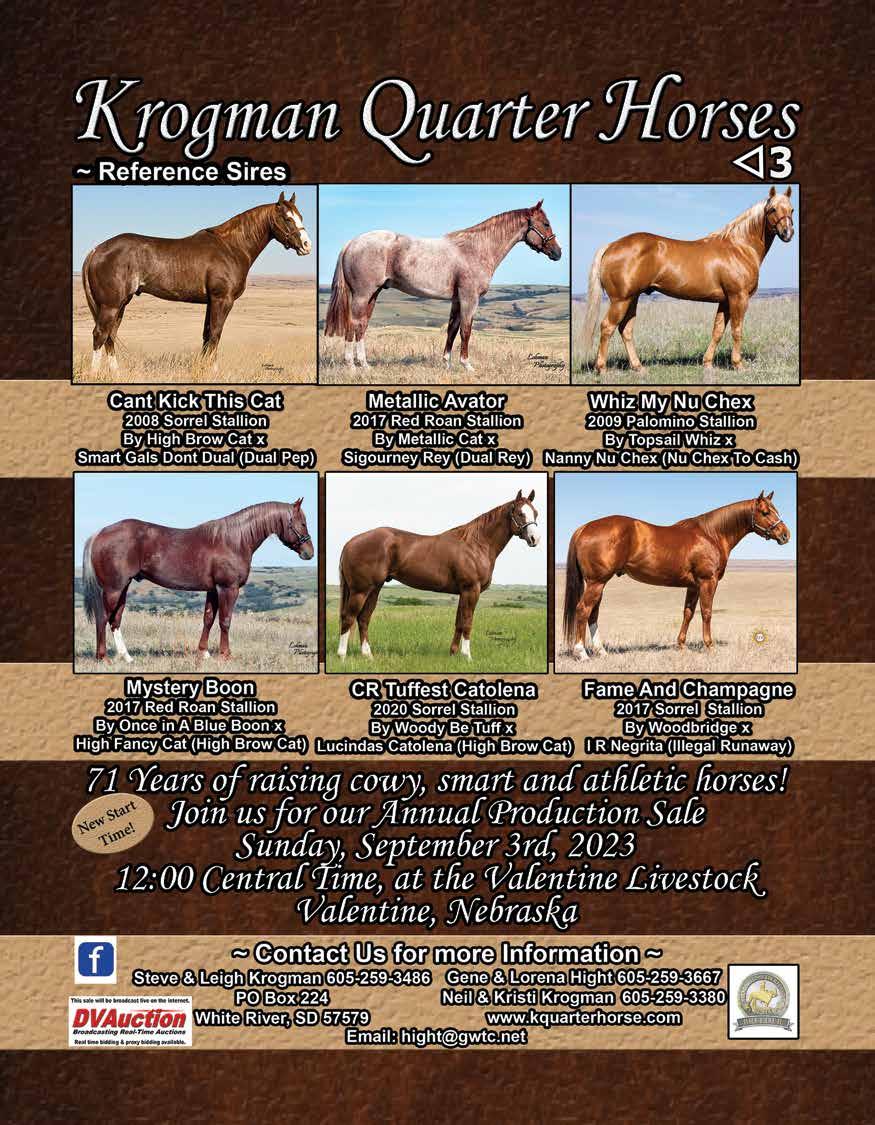




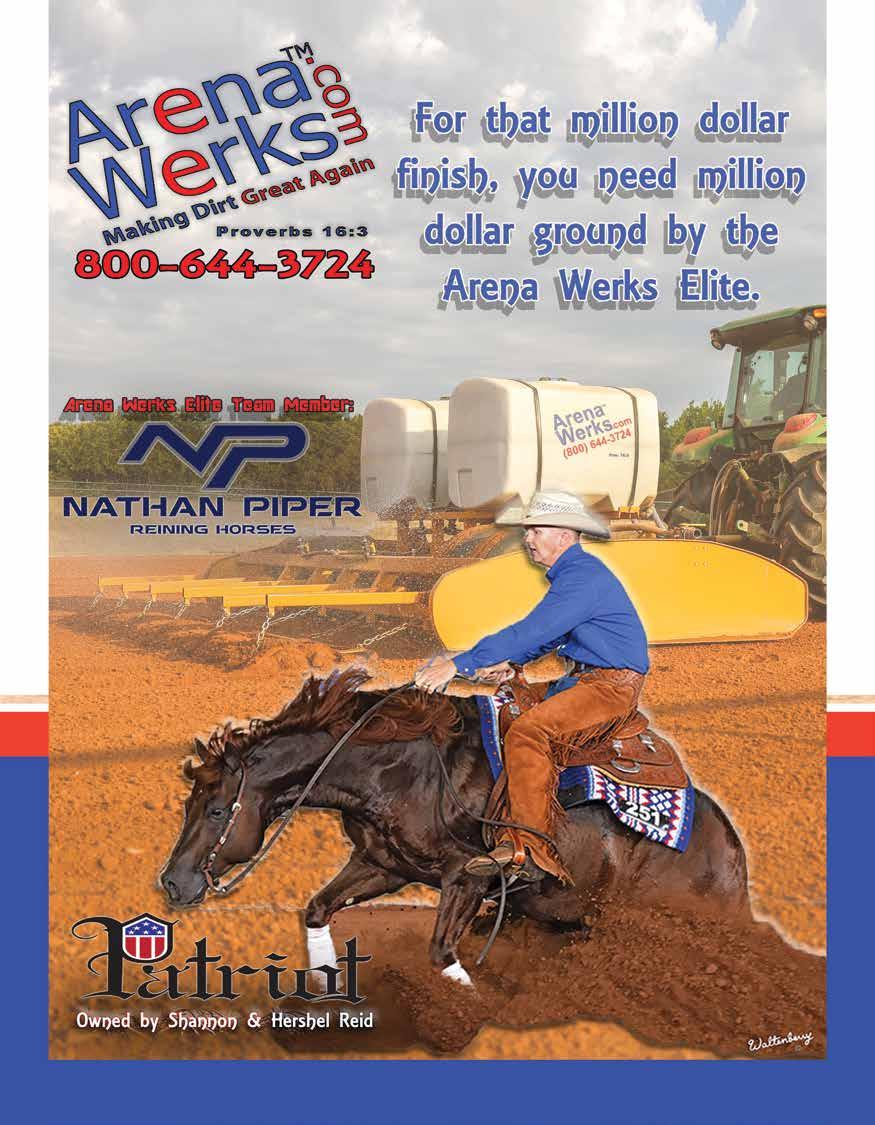







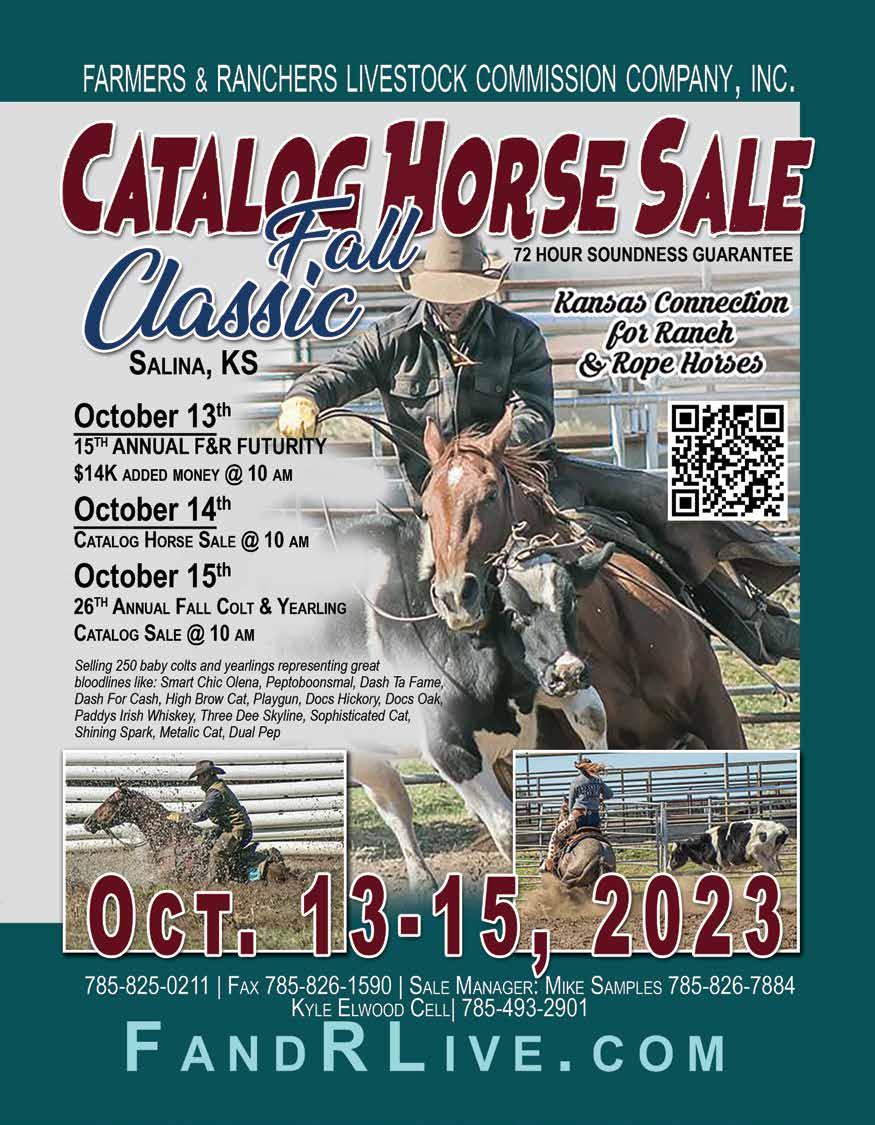


56 Working Horse Magazine suMMer 2023






60 Working Horse Magazine suMMer 2023






Working Horse Magazine suMMer 2023 61 The Original Source For Blue Valentine Bloodlines Production Sale August 26, 2023 Laramie, Wyoming Randy Dunn 307-742-4669 Chip Merritt 970-215-6137 Dick Van Pelt 307-760-1452 Call or visit our website: ComeToTheSource.com Ranch Raised Versatile Athletic Ability Celebrating 25 Years! Call for more info!

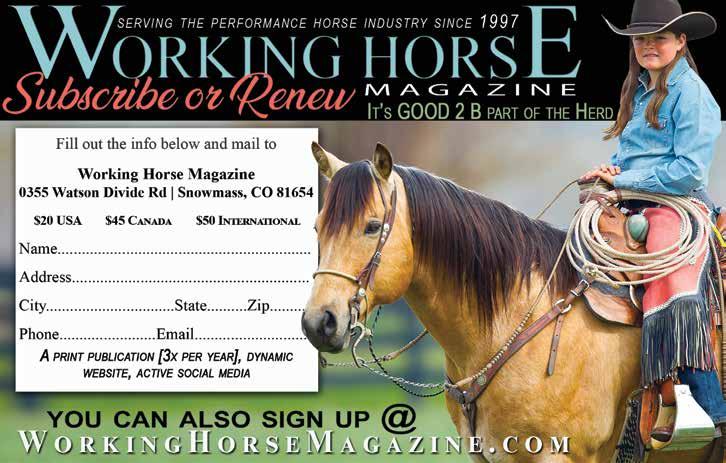
62 Working Horse Magazine suMMer 2023
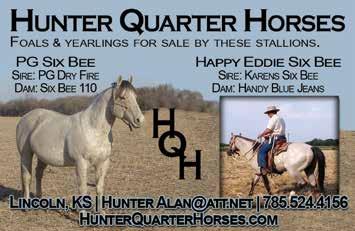




Working Horse Magazine suMMer 2023 63

Pitzer Ranch Ericson, NE 8th|9th
BV&D
Box Rafter Rapid City, SD 9th
Sutton Gettysburg, SD 17th
Hermanson-Kist Mandan,
QH Great Falls, MT 16th
Ozark
Legacy
Bars
Jamison
6666
Cannon
& Ranchers Salina, KS 13th|15th
Sales Tecumseh, OK 26th|28th
Nile Billings, MT 27th Pieper Red Angus Sale Hay Springs, NE 28th
Ranches Wells, NV 19th
Blain
to the Sourse Laramie,
QH Classic Ogallala, NE 26th
Belle Fourche, SD 27th Lauing Mill Iron Online 27th|30th
September Huskerland
Lolli
Munns
Spader
Krogman Valentine, NE 3rd
Breeders Classic Mobridge, SD 8th
Reindl
Horse Sale Belle Fourche, SD 10th

Memory
Come
Nebraska
RQHBA
Louie
Dakota
AK
Open
Raymond
Weaver
Sugar
October
Farmers
Triangle
August Lapke The
+ Sanchau Production Sale Dunlap, IA 19th
Krogman Online 19th|26th
WY 26th
Burwell, NE 2nd
Bros. Macon, MO 2nd
Prod. Sale Rexburg, ID 2nd
Ranch Kansas City, KS 2nd
Online Horse Sale 9th|12th
Springfield, MO 9th
ND 14th|16th
FB Midway, AR 16th
Sheridan, WY 17th Shawnee Horse Sales Shawnee, OK 30th
Quiter, KS 5th
Guthrie, TX 6th-7th Waverly Fall Sale Waverly, IA 6th|8th Twin Cities Horse Sale
Falls, MN 7th





















 By Larry Thornton
By Larry Thornton








































































